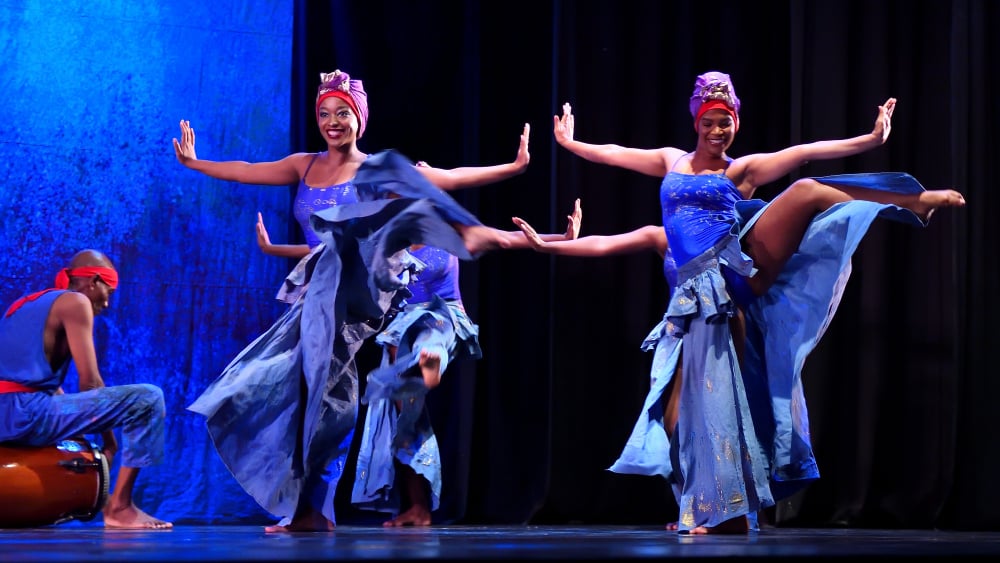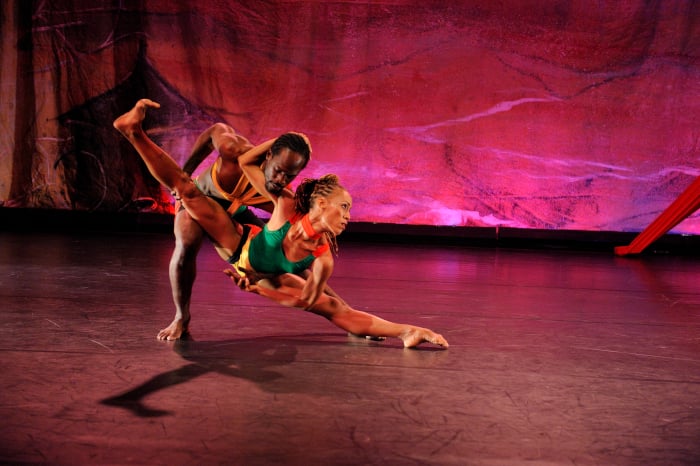
Culture & Community | Dance | Arts & Culture | Youth Arts Journalism Initiative | Shubert Theatre
%20D91_6734.jpg?width=933&height=525&name=Drumscore%20(Chor.%20Rex%20Nettleford%2c%201979)%20D91_6734.jpg)
Photos Courtesy of the Shubert Theatre.
The audience was silent in anticipation as two spotlights emerged. Splitting stage left and right, two drummers began hammering out a beat, translating into sound the Ghanaian proverb “When God created the earth, He first created the drummer.”
In front of the drummers, dancers knelt with their heads low to the ground. As the drums picked up their pace, a man and woman rose, beaming and clothed in red headwraps. The duo began to sing, and the National Dance Theater Company (NDTC) of Jamaica launched into “Drumscore.”
As if on cue, audience members rose to the music and began to sing along. This was "Jamaica, Land We Love," the National Anthem of Jamaica. And on a recent Friday, it could be taken as a prelude to the performance to come.
Earlier this month, “Drumscore” was an introduction to the NDTC as it graced the Shubert Theatre for the first time in its six decades. Over three hours of explosive, joyful and bright movement, the performance became a celebration of not just 60 years of dance, but the importance and legacy of Jamaica as an independent nation.
“I’m helping to preserve the culture as a means of self-expression,” dancer Phillip Earle had said during a master class earlier in the day, and the words seemed immediately alive. “It’s energy. It keeps you active, and in general, it’s a way of sharing who you are.”
Immediately upon taking the stage Friday, dancers established connection—with the audience, with each other—as a central goal of the performance. From the stage, attendees could feel the exchange of energy in real time as it radiated off the dancers. Blending cultural, contemporary, and modern dance styles, company members didn’t merely dance–they performed history and culture, bringing a taste of Jamaica around the world.
Viewers, some of whom sat spellbound and slack-jawed for much of the performance, could see that in the company's third piece, entitled “Unbroken.” The work, which features all of the female members in the company, was choreographed in 2022, making it one of the newest and most modern pieces of choreography in the company’s repertoire.
As house lights remained low, the piece began with the backing track of a violin and a soloist onstage. Clothed in a red and black dress, a dancer moved in contemporary fashion, turning on one leg with her working leg bent behind her. She angled herself parallel to the ground, throwing battlement kicks with flexed feet. As the story progressed, more women made their way onstage, ushering in a monologue.
The message was clear: this was a piece about strength in womanhood. Dancing to Amanda Gorman’s spoken word piece “We Rise,” dancers translated her words into movement.
We press for change, / A new dawn drawn into the open / By women whose silence is broken. Dancers rushed onstage, protecting and supporting the initial soloist. Once the support was there, it never left. Dancers created solid formations of three, five, ten—but no woman was ever left without support again.
.jpg?width=933&height=933&name=Tamara%20Noel%20and%20Phillip%20Earle%20in%20Rex%20Nettleford_s%20Drumscore%20(1979).jpg)
Tamara Noel and Phillip Earle in Rex Nettleford's Drumscore (1979). Photos Courtesy of the Shubert Theatre.
Dancers transitioned into different formations–huddling and searching the audience, breaking into a unified choreography. Reflecting the strength of their story, dancers utilized the Lester Horten dance technique. The Horten technique is a modern dance technique that utilizes the entire body through flexibility, coordination, and strength.
As they remained in tight formations, dancers incorporated classic Horton wide second stances with their legs hip-width apart and feet turned out in a natural stance, and arms strengthened into straight lines.
We push on and act on / Our responsibility to bring visibility / To the most vulnerable: / To bring freedom to those who didn’t have a choice, / To bring volume to those who are using their voice. The dancers flowed into lifts, working together in choreography full of modern and contemporary leg développé, holds, and arabesques.
The emotional weight of the piece came in waves as dancers searched the audience, huddled together in fear, and jerked in pain. As Gorman’s words ended, live drumming and music took over. With sharp movements, possé turns, and running across the stage, the dancers fully immersed themselves into the performance. It seemed they were acting out roles they’ve known all their lives.
It was just one example of how the company, whether on tour or at home in Kingston, Jamaica, is one that fights against all expectations and trains its dancers in both contemporary and traditional styles.

"Rough Drafts." Photos Courtesy of the Shubert Theatre.
Immediately following “Unbroken,” audience members listened to a brief musical interlude that launched into the ambitious odyssey “Rough Drafts.” Split into five parts, “Rough Drafts” introduced dancers being consumed by props of fabric while they lay in abstract positions and were dragged across the stage.
Storytelling remained a theme in the NDTC’s catalog, as dancers transformed into creatures in a deserted land. “Rough Drafts” began with a slow and ominous start, with synthy music accompanying the deserted setting, and lights rose, dancers began to roll out of the fabric they were trapped in.
From stage left, dancers emerged standing on the shoulders of their partners, and Part I, “Burden Bearers,” began.
Center stage, a man stood and struggled to lift his female partner up on his shoulders. Abruptly, she dropped to the ground with a thud. Upstage right, a trio of dancers repeated the movements with bent arms parallel to the ground, and deep second pliés. Downstage left, a formation of women gripped onto each other in a line and individually made their way to the man center stage.
Each woman was lifted with difficulty, ultimately collapsing to the ground in front of them. All the while, the fabric remained on the ground, laying the scene.
Throughout the entire piece, dancers came on and off stage with costume changes, new stunts, and energy. Heavily influenced by modern dance, “Rough Drafts” doubled as a reflection of grace, patience, and control. Featuring the entire dance company, it was also a large production that showed the time and energy put into the NDTC.
Closing out the show was a piece entitled “Gerrehbenta.” Choreographed in 1983, “Gerrehbenta” received its name from two of the major traditional rites practiced in Jamaica. These are the “gerreh” in Hanover & “dinky-mini” which uses the musical instrument, the benta, in St. Mary. As its namesake suggests, “Gerrehbenta” is a cultural piece full of lively movement and audience interaction.
With colorful costumes individual to each dancer, the scene was set. Two drummers split stage left and right, calling viewers back to the first dance of the show, and two dancers emerged from backstage and made their way to the tall clothed dragon head in center stage.
Setting off into live music, the remaining members of the company emerged from both sides of the stage, and set off into a celebratory choreography of bent arms, hands placed on hips, and popping chests. Transitioning into group work, various groups took turns coming on and off the stage to perform the same choreographic sequence composed of quick footwork and fan kicks, whipping from corner to corner across the dancer's bodies.
The groups varied from entirely female quartets, male trios, and mixed duets, but the choreography remained the same and was performed with the same strength, intent, and enthusiasm.
Offstage, in view of the audience and dressed in black, the vocal company of the NDTC supported the final performance by singing live.
“Gerrehbenta” was littered with deep forward lunges, battlements with flexed feet, and quick footwork. Within their bodies, dancers shook their hips, popped their chests out, and moved their shoulders to the music. Up top, the faces of dancers were lively and smiling as they interact with each other onstage, dancing together and circling around the central dragon prop.
Within the audience, people were waving Jamaican flags, clapping to the music, dancing in their seats, and laughing with the dancers as they performed.
Leaving the theater, audience members spoke of coming back for the company’s final performance at the Shubert on Saturday, and the presence of the Caribbean Island within New Haven. It seemed like Jamaica was not so far away at all.
Jayla Anderson is a rising senior at Cooperative Arts & Humanities High School and an alum of the Youth Arts Journalism Initiative.

